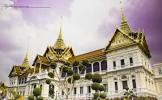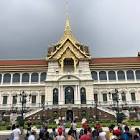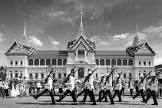Attraction พระที่นั่งจักรีมหาปราสาท/The Chakri Maha Prasat Throne Hall : กรุงเทพมหานคร
In the western mansion on the top floor are kept the ashes of queens and high ranking princes and princesses.

พระที่นั่งจักรีมหาปราสาท/The Chakri Maha Prasat Throne Hall
![]()
The middle floor serves as guests's chamber where on the wall are hung the portraits of King Rama VII and
![]()
Her Majesty Queen Rambhai Barni. The lowest floor serves as library.
![]()
A gallery joins the central mansion to the eastern mansion. The middle floor is divided lengthwise into two
![]()
parts. The inner part is a reception room where the portraits of the kings of the Chakri Dynasty from King Rama
![]()
I to King Rama VII are hung. The outer part is a verandah which connects the throne hall to the reception hall.
![]()
Another gallery joins the central mansion to the western one. The middle floor is an open hall for receiving
![]()
guests. On the wall there are portraits of the Queens of King Rama IV, Rama V and Rama VII. The ground floor
![]()
is also and open hall.
![]()
In the rear centre of the Chakri Maha Prasat Hall is the Chakri Throne Room where the King receives ambassadors
![]()
on the occasion of the presentation of their credentials. At the end of the room stands the throne called Phuttanthom
![]()
Throne, made of wood covered with silver and gold foil. A nine-tiered white Conopy made for King Chulalongkorn
![]()
stands over this throne. The emblem of the Chakri Dynasty is depicted on the wall behind the throne. The other
![]()
walls are decorated with four canvasses depicting deplomatic receptions of the past. One on the right as one enters
![]()
the room depicts the reception by Queen Victoria of King Mongkut's ambassador in London, further on is Louis
![]()
XIV's recoption of the mission sent by King Narai the Great of Ayutthaya in the Gallerie des Glaces in the palace
![]()
of Versailles ; the third, on the other side of the room, King Mongkut's reception of the French Envoy, and the
![]()
fourth, the reception at Fontainebleau by the Emperor Napoleon III of another Siamese Mission. The cryltal
![]()
decorations of the hall are mostly presents from foreign monarches to King Chulalongkorn.
![]()
![]()
![]()
'>
![]()
ประวัติของพระที่นั่งจักรีมหาปราสาท พระที่นั่งจักรีมหาปราสาท" นั้นเป็นพระที่นั่งที่พระบาทสมเด็จพระจุลจอมเกล้าเจ้าอยู่หัวโปรดเกล้าฯ ให้สร้างขึ้น เมื่อพ.ศ. 2419 หลังเสด็จประพาสสิงค์โปร์ เป็นพระที่นั่งที่สร้างขึ้นใหม่ ในพระบรมมหาราชวัง ตามธรรมเนียมโบราณที่กษัตริย์มักนิยมสร้างปราสาทมาทุกสมัย และเพื่อเตรียมใช้เพื่อเฉลิมฉลองการสมโภชกรุงรัตนโกสินทร์ครบ 100 ปี ซึ่งพระที่นั่งจักรีมหาปราสาทนี้ พระบาทสมเด็จพระจุลจอมเกล้าเจ้าอยู่หัว โปรดเกล้าฯ ให้จ้างสถาปนิกชาวอังกฤษจากสิงคโปร์ ชื่อ มิสเตอร์ ยอน คลูนิช ทำหน้าที่เป็นนายช่างออกแบบถวายตามพระราชดำริ โดยสร้างตามแบบอย่างศิลปกรรมตะวันตก มีหลังคากลมซึ่งเป็นที่นิยมอยู่ในขณะนั้น แต่สมเด็จเจ้าพระยาบรมมหาศรีสุริยวงศ์ (ช่วง บุนนาค) กราบบังคมทูลพระกรุณาว่าสมควรสร้างเป็นปราสาทจึงจะเหมาะสม เพราะเมื่อครั้งกรุงศรีอยุธยา มีการสร้างปราสาทเรียงกัน 3 องค์ ในสมัยกรุงรัตนโกสินทร์ มีการสร้างอยู่แล้ว 2 องค์ คือ พระที่นั่งจักรพรรดิพิมาน กับ พระที่นั่งดุสิตมหาปราสาท นอกจากนี้การสร้างพระมหาปราสาทนั้นถือกันมาแต่โบราณว่า เป็นการเฉลิมพระเกียรติยศของสมเด็จพระมหากษัตริยาธิราชเจ้าที่ทรงสร้างด้วย จึงมีพระราชดำริเห็นชอบและโปรดเกล้าฯให้สร้างพระที่นั่งจักรีมหาปราสาทเป็นแบบผสมผสานระหว่างสถาปัตยกรรมไทย และสถาปัตยกรรมตะวันตก คือ เป็นปราสาท 3 ชั้น 3 องค์ เรียงกัน มีมุขกระสันเชื่อมต่อกัน ลักษณะผสมแบบศิลปะไทยกับยุโรป องค์พระที่นั่งเป็นแบบสถาปัตยกรรมยุโรป แต่หลังคาเป็นยอดปราสาทแบบไทย 3 ยอด ยอดทรงมณฑปซ้อน 7 ชั้น มีมุมไม้สิบสองทั้ง 4 มุม หลัง คาเป็นหลังคาชั้นลด 2 ชั้น มุงกระเบื้องเคลือบสี มีช่อฟ้า ใบระกา หางหงส์ลักษณะของพระที่นั่งจักรีมหาปราสาทสำหรับลักษณะอาคารที่ปรากฏในปัจจุบันมีรายละเอียดดังนี้ องค์กลาง - ชั้นบน เป็นหอพระบรมอัฐิ มีมุขเด็จสำหรับเสด็จออกด้านหน้า ชั้นกลาง เป็นท้องพระโรงหน้า ผนัง ห้องพระโรงหน้า ผนังห้อง - แขวนพระบรมฉายาลักษณ์พระบาทสมเด็จพระเจ้าอยู่หัวรัชกาลที่ 9 และสมเด็พระบรมราชินีนาถ ชั้นล่าง - เป็นกองรักษาการณ์มหาดเล็กรักษาพระองค์องค์ตะวันออก - ชั้นบน เป็นที่ประดิษฐานปูชนียวัตถุ ชั้นกลาง เป็นห้องรับรองพระราชอาอันตุกะ ผนัง ห้องแขวนพระบรมฉายาลักษณ์รัชกาลที่ 5 ร่วมกับสมเด็จพระบรมราชินีนาถ และพระบรมราชโอรสที่ 5 ชั้นล่าง เป็นห้องรับแขกองค์ตะวันตก - ชั้นบน ประดิษฐานพระอัฐิพระมเหสีและพระบรมราชวงศ์ ชั้นกลาง เป็นห้องรับแขก ชั้นล่าง เป็นห้องสมุดมุขกระสันด้านตะวันออก - ชั้นบน เป็นเฉลียงเชื่อม ชั้นกลาง เป็นห้องโถงแบ่งเป็นสองตอน ตอนในเป็นห้องรับรอง ผนัง ประดับพระบรมฉายาลักษณ์พระราชินีในรัชกาลที่ 4,5 และ 7 ชั้นล่าง เป็นห้องโถงท้องพระโรงกลาง - อยู่ต่อจากท้องพระโรงหน้า สำหรับเสด็จออกให้คณะทูตานุทูตเข้าเฝ้าฯ และใช้ ประกอบพระราชพิธีการกุศล หรือพระราชกรณียกิจอื่นๆ ในรัชกาลที่ 5 ใช้เป็นที่เสด็จออกขุนนางด้วย ภายใน ประดิษฐานพระแท่นพุดตานถน ซึ่งเป็นพระราชบัลลังก์ ประจำพระที่นั่งจักรีมหาปราสาท มีภาพเขียนประวัติ ความเจริญทางพระไมตรีของไทยกับอังกฤษและฝรั่งเศสท้องพระโรงหลัง - อยู่หลังถัดจากท้องพระโรงกลาง ในรัชกาลที่ 5 เป็นที่สำหรับฝ่ายในเข้า เฝ้าในพระราชพิธีที่จัดในท้องพระโรงกลาง การตกแต่งพระที่นั่งจักรีมหาปราสาทเนื่องในวโรกาสฉลองสิริราชสมบัติครบ 60 ปี เพื่อเป็นการเทิดพระเกียรติพระบาทสมเด็จพระเจ้าอยู่หัว รัฐบาลได้ทำการตกแต่งพระที่นั่งจักรีมหาปราสาท (ส่วนต่อเติม) จากงบประมาณรายจ่าย ประจำปีงบประมาณ พ.ศ. 2549 งบกลาง รายการเงินสำรองจ่าย เพื่อกรณีฉุกเฉินหรือจำเป็น สำหรับรายการตกแต่งพระที่นั่งฯ ในวงเงิน 500 ล้านบาท ซึ่งสำนักพระราชวัง ได้กราบบังคมทูลพระกรุณา ทราบฝ่าละอองธุลีพระบาท ในการที่ รัฐบาล ได้ น้อมเกล้าฯ ถวาย การสนับสนุนงบประมาณดังกล่าวแล้ว ซึ่งนับว่า เป็นพระที่นั่งแห่งแรกที่มีการจัดสร้างในรัชกาลปัจจุบัน และในการนี้พระบาทสมเด็จพระเจ้าอยู่หัวทรงพระราชทานนามพระที่นั่งจักรีมหาปราสาทส่วนต่อเติมว่า"พระที่นั่งบรมราชสถิตมโหฬาร"สำหรับพระที่นั่งบรมราชสถิตมโหฬาร เป็นพระที่นั่งองค์ใหม่ที่สร้างขึ้น เพิ่งเสร็จเรียนร้อยทันงานเฉลิมฉลองการครองราชย์สมบัติครบ 60 ปี โดยพระบาทสมเด็จพระเจ้าอยู่หัว ได้พระราชทานนามว่า พระที่นั่งบรมราชสถิตมโหฬารพระที่นั่งบรมราชสถิตมโหฬาร มีความสูงเท่ากับตึก 11 ชั้น ซึ่งสูงกว่าพระที่นั่งจักรีมหาปราสาท 4 ชั้น ภายในปูพื้นด้วยหินอ่อน สั่งตรงจากประเทศอิตาลี มีการประดับตกแต่งอย่างสวยงาม โดยสมเด็จพระนางเจ้าฯพระบรมราชินีนาถ ได้พระราชทาน“กูบช้างทองคำ” “กูบช้างถมทอง” “กูบช้างคร่ำทอง” และ “กูบช้างเงิน”ป็นเครื่องประดับภายในไม่เพียงเท่านั้น ยังได้พระราชทาน “บุษบกทองคำ” และ “บานไม้จำหลัก” ที่เคยประดิษฐานอยู่ที่พระที่นั่งจักรีมหา-ปราสาท ย้ายมาประดิษฐานไว้ที่พระที่นั่งองค์ใหม่ด้วยส่วนผู้ที่ได้รับคัดเลือกจากรัฐบาลให้เข้าไปวาดภาพตกแต่งภายในพระที่นั่งองค์ใหม่นี้ คือ จักรพันธุ์ โปษยกฤต ศิลปินแห่งชาติ สาขาทัศนศิลป์จิตรกรรม พ.ศ.2543 ผู้ที่มีผลงานสวยสดงดงามและมีชื่อเสียงของเมืองไทย วาดภาพพระบรมสาทิสลักษณ์ประดับ ในพระที่นั่งดังกล่าว ทั้งนี้พระที่นั่งบรมราชสถิตมโหฬาร จะใช้เป็นสถานที่เลี้ยงพระกระยาหารค่ำพระราชอาคันตุกะ ในวันที่ 13 มิ.ย. ที่ผ่านมา
![]()
![]()
The Chakri Maha Prasat Throne Hall พระที่นั่งจักรีมหาปราสาท
![]()
Located between the Halls Group and Dusit Maha Prasat Throne Hall. Chakri Maha Prasat Throne Hall was
![]()
constructed during the reign of King Chulalongkorn to commemorate the centenary of the Chakri Dynasty.
![]()
It was designed by a British architect, in the European style with a roof in pure Thai style, thus blending East
![]()
and West. Construction lasted for six years from 1876 to 1882. The roof has three spires of seven-tiered
![]()
pavilion style. "At the four corner of the base of the spires there used to be mouldings of Garudas Nagas as
![]()
decorative supports., but during renovation in King Rama VII's reign they were replaced by swan-shaped
![]()
brackets. The roof is in two-tiers and covered with coloured glazed tiles.
![]()
On the top floor of the central mansion the royal ashes are kept and the king gives public audience from a front
![]()
projection there of. The second floor serves as an audience hall where portraits of the present King and Queen
![]()
are displayed. On the ground floor is the office of the royal guards.
![]()
In the eastern mansion, religious objects are kept on the top floor. The middle floor serves as reception hall
![]()
for royal-guests. On the wall the family portrait of King Chulalongkorn, his Queen Si-Bacharindra and their five
![]()
sons is hung. The lowest floor server as a guest' waiting room.
![]()
In the western mansion on the top floor are kept the ashes of queens and high ranking princes and princesses.
![]()
The middle floor serves as guests's chamber where on the wall are hung the portraits of King Rama VII and
![]()
Her Majesty Queen Rambhai Barni. The lowest floor serves as library.
![]()
A gallery joins the central mansion to the eastern mansion. The middle floor is divided lengthwise into two
![]()
parts. The inner part is a reception room where the portraits of the kings of the Chakri Dynasty from King Rama
![]()
I to King Rama VII are hung. The outer part is a verandah which connects the throne hall to the reception hall.
![]()
Another gallery joins the central mansion to the western one. The middle floor is an open hall for receiving
![]()
guests. On the wall there are portraits of the Queens of King Rama IV, Rama V and Rama VII. The ground floor
![]()
is also and open hall.
![]()
In the rear centre of the Chakri Maha Prasat Hall is the Chakri Throne Room where the King receives ambassadors
![]()
on the occasion of the presentation of their credentials. At the end of the room stands the throne called Phuttanthom
![]()
Throne, made of wood covered with silver and gold foil. A nine-tiered white Conopy made for King Chulalongkorn
![]()
stands over this throne. The emblem of the Chakri Dynasty is depicted on the wall behind the throne. The other
![]()
walls are decorated with four canvasses depicting deplomatic receptions of the past. One on the right as one enters
![]()
the room depicts the reception by Queen Victoria of King Mongkut's ambassador in London, further on is Louis
![]()
XIV's recoption of the mission sent by King Narai the Great of Ayutthaya in the Gallerie des Glaces in the palace
![]()
of Versailles ; the third, on the other side of the room, King Mongkut's reception of the French Envoy, and the
![]()
fourth, the reception at Fontainebleau by the Emperor Napoleon III of another Siamese Mission. The cryltal
![]()
decorations of the hall are mostly presents from foreign monarches to King Chulalongkorn.
![]()
![]()
![]()
'>
![]()
brackets. The roof is in two-tiers and covered with coloured glazed tiles.
![]()
On the top floor of the central mansion the royal ashes are kept and the king gives public audience from a front
![]()
projection there of. The second floor serves as an audience hall where portraits of the present King and Queen
![]()
are displayed. On the ground floor is the office of the royal guards.
![]()
In the eastern mansion, religious objects are kept on the top floor. The middle floor serves as reception hall
![]()
for royal-guests. On the wall the family portrait of King Chulalongkorn, his Queen Si-Bacharindra and their five
![]()
sons is hung. The lowest floor server as a guest' waiting room.
![]()
In the western mansion on the top floor are kept the ashes of queens and high ranking princes and princesses.
![]()
The middle floor serves as guests's chamber where on the wall are hung the portraits of King Rama VII and
![]()
Her Majesty Queen Rambhai Barni. The lowest floor serves as library.
![]()
A gallery joins the central mansion to the eastern mansion. The middle floor is divided lengthwise into two
![]()
parts. The inner part is a reception room where the portraits of the kings of the Chakri Dynasty from King Rama
![]()
I to King Rama VII are hung. The outer part is a verandah which connects the throne hall to the reception hall.
![]()
Another gallery joins the central mansion to the western one. The middle floor is an open hall for receiving
![]()
guests. On the wall there are portraits of the Queens of King Rama IV, Rama V and Rama VII. The ground floor
![]()
is also and open hall.
![]()
In the rear centre of the Chakri Maha Prasat Hall is the Chakri Throne Room where the King receives ambassadors
![]()
on the occasion of the presentation of their credentials. At the end of the room stands the throne called Phuttanthom
![]()
Throne, made of wood covered with silver and gold foil. A nine-tiered white Conopy made for King Chulalongkorn
![]()
stands over this throne. The emblem of the Chakri Dynasty is depicted on the wall behind the throne. The other
![]()
walls are decorated with four canvasses depicting deplomatic receptions of the past. One on the right as one enters
![]()
the room depicts the reception by Queen Victoria of King Mongkut's ambassador in London, further on is Louis
![]()
XIV's recoption of the mission sent by King Narai the Great of Ayutthaya in the Gallerie des Glaces in the palace
![]()
of Versailles ; the third, on the other side of the room, King Mongkut's reception of the French Envoy, and the
![]()
fourth, the reception at Fontainebleau by the Emperor Napoleon III of another Siamese Mission. The cryltal
![]()
decorations of the hall are mostly presents from foreign monarches to King Chulalongkorn.
![]()
![]()
![]()
'>
![]()
ประวัติของพระที่นั่งจักรีมหาปราสาท พระที่นั่งจักรีมหาปราสาท" นั้นเป็นพระที่นั่งที่พระบาทสมเด็จพระจุลจอมเกล้าเจ้าอยู่หัวโปรดเกล้าฯ ให้สร้างขึ้น เมื่อพ.ศ. 2419 หลังเสด็จประพาสสิงค์โปร์ เป็นพระที่นั่งที่สร้างขึ้นใหม่ ในพระบรมมหาราชวัง ตามธรรมเนียมโบราณที่กษัตริย์มักนิยมสร้างปราสาทมาทุกสมัย และเพื่อเตรียมใช้เพื่อเฉลิมฉลองการสมโภชกรุงรัตนโกสินทร์ครบ 100 ปี ซึ่งพระที่นั่งจักรีมหาปราสาทนี้ พระบาทสมเด็จพระจุลจอมเกล้าเจ้าอยู่หัว โปรดเกล้าฯ ให้จ้างสถาปนิกชาวอังกฤษจากสิงคโปร์ ชื่อ มิสเตอร์ ยอน คลูนิช ทำหน้าที่เป็นนายช่างออกแบบถวายตามพระราชดำริ โดยสร้างตามแบบอย่างศิลปกรรมตะวันตก มีหลังคากลมซึ่งเป็นที่นิยมอยู่ในขณะนั้น แต่สมเด็จเจ้าพระยาบรมมหาศรีสุริยวงศ์ (ช่วง บุนนาค) กราบบังคมทูลพระกรุณาว่าสมควรสร้างเป็นปราสาทจึงจะเหมาะสม เพราะเมื่อครั้งกรุงศรีอยุธยา มีการสร้างปราสาทเรียงกัน 3 องค์ ในสมัยกรุงรัตนโกสินทร์ มีการสร้างอยู่แล้ว 2 องค์ คือ พระที่นั่งจักรพรรดิพิมาน กับ พระที่นั่งดุสิตมหาปราสาท นอกจากนี้การสร้างพระมหาปราสาทนั้นถือกันมาแต่โบราณว่า เป็นการเฉลิมพระเกียรติยศของสมเด็จพระมหากษัตริยาธิราชเจ้าที่ทรงสร้างด้วย จึงมีพระราชดำริเห็นชอบและโปรดเกล้าฯให้สร้างพระที่นั่งจักรีมหาปราสาทเป็นแบบผสมผสานระหว่างสถาปัตยกรรมไทย และสถาปัตยกรรมตะวันตก คือ เป็นปราสาท 3 ชั้น 3 องค์ เรียงกัน มีมุขกระสันเชื่อมต่อกัน ลักษณะผสมแบบศิลปะไทยกับยุโรป องค์พระที่นั่งเป็นแบบสถาปัตยกรรมยุโรป แต่หลังคาเป็นยอดปราสาทแบบไทย 3 ยอด ยอดทรงมณฑปซ้อน 7 ชั้น มีมุมไม้สิบสองทั้ง 4 มุม หลัง คาเป็นหลังคาชั้นลด 2 ชั้น มุงกระเบื้องเคลือบสี มีช่อฟ้า ใบระกา หางหงส์ลักษณะของพระที่นั่งจักรีมหาปราสาทสำหรับลักษณะอาคารที่ปรากฏในปัจจุบันมีรายละเอียดดังนี้ องค์กลาง - ชั้นบน เป็นหอพระบรมอัฐิ มีมุขเด็จสำหรับเสด็จออกด้านหน้า ชั้นกลาง เป็นท้องพระโรงหน้า ผนัง ห้องพระโรงหน้า ผนังห้อง - แขวนพระบรมฉายาลักษณ์พระบาทสมเด็จพระเจ้าอยู่หัวรัชกาลที่ 9 และสมเด็พระบรมราชินีนาถ ชั้นล่าง - เป็นกองรักษาการณ์มหาดเล็กรักษาพระองค์องค์ตะวันออก - ชั้นบน เป็นที่ประดิษฐานปูชนียวัตถุ ชั้นกลาง เป็นห้องรับรองพระราชอาอันตุกะ ผนัง ห้องแขวนพระบรมฉายาลักษณ์รัชกาลที่ 5 ร่วมกับสมเด็จพระบรมราชินีนาถ และพระบรมราชโอรสที่ 5 ชั้นล่าง เป็นห้องรับแขกองค์ตะวันตก - ชั้นบน ประดิษฐานพระอัฐิพระมเหสีและพระบรมราชวงศ์ ชั้นกลาง เป็นห้องรับแขก ชั้นล่าง เป็นห้องสมุดมุขกระสันด้านตะวันออก - ชั้นบน เป็นเฉลียงเชื่อม ชั้นกลาง เป็นห้องโถงแบ่งเป็นสองตอน ตอนในเป็นห้องรับรอง ผนัง ประดับพระบรมฉายาลักษณ์พระราชินีในรัชกาลที่ 4,5 และ 7 ชั้นล่าง เป็นห้องโถงท้องพระโรงกลาง - อยู่ต่อจากท้องพระโรงหน้า สำหรับเสด็จออกให้คณะทูตานุทูตเข้าเฝ้าฯ และใช้ ประกอบพระราชพิธีการกุศล หรือพระราชกรณียกิจอื่นๆ ในรัชกาลที่ 5 ใช้เป็นที่เสด็จออกขุนนางด้วย ภายใน ประดิษฐานพระแท่นพุดตานถน ซึ่งเป็นพระราชบัลลังก์ ประจำพระที่นั่งจักรีมหาปราสาท มีภาพเขียนประวัติ ความเจริญทางพระไมตรีของไทยกับอังกฤษและฝรั่งเศสท้องพระโรงหลัง - อยู่หลังถัดจากท้องพระโรงกลาง ในรัชกาลที่ 5 เป็นที่สำหรับฝ่ายในเข้า เฝ้าในพระราชพิธีที่จัดในท้องพระโรงกลาง การตกแต่งพระที่นั่งจักรีมหาปราสาทเนื่องในวโรกาสฉลองสิริราชสมบัติครบ 60 ปี เพื่อเป็นการเทิดพระเกียรติพระบาทสมเด็จพระเจ้าอยู่หัว รัฐบาลได้ทำการตกแต่งพระที่นั่งจักรีมหาปราสาท (ส่วนต่อเติม) จากงบประมาณรายจ่าย ประจำปีงบประมาณ พ.ศ. 2549 งบกลาง รายการเงินสำรองจ่าย เพื่อกรณีฉุกเฉินหรือจำเป็น สำหรับรายการตกแต่งพระที่นั่งฯ ในวงเงิน 500 ล้านบาท ซึ่งสำนักพระราชวัง ได้กราบบังคมทูลพระกรุณา ทราบฝ่าละอองธุลีพระบาท ในการที่ รัฐบาล ได้ น้อมเกล้าฯ ถวาย การสนับสนุนงบประมาณดังกล่าวแล้ว ซึ่งนับว่า เป็นพระที่นั่งแห่งแรกที่มีการจัดสร้างในรัชกาลปัจจุบัน และในการนี้พระบาทสมเด็จพระเจ้าอยู่หัวทรงพระราชทานนามพระที่นั่งจักรีมหาปราสาทส่วนต่อเติมว่า"พระที่นั่งบรมราชสถิตมโหฬาร"สำหรับพระที่นั่งบรมราชสถิตมโหฬาร เป็นพระที่นั่งองค์ใหม่ที่สร้างขึ้น เพิ่งเสร็จเรียนร้อยทันงานเฉลิมฉลองการครองราชย์สมบัติครบ 60 ปี โดยพระบาทสมเด็จพระเจ้าอยู่หัว ได้พระราชทานนามว่า พระที่นั่งบรมราชสถิตมโหฬารพระที่นั่งบรมราชสถิตมโหฬาร มีความสูงเท่ากับตึก 11 ชั้น ซึ่งสูงกว่าพระที่นั่งจักรีมหาปราสาท 4 ชั้น ภายในปูพื้นด้วยหินอ่อน สั่งตรงจากประเทศอิตาลี มีการประดับตกแต่งอย่างสวยงาม โดยสมเด็จพระนางเจ้าฯพระบรมราชินีนาถ ได้พระราชทาน“กูบช้างทองคำ” “กูบช้างถมทอง” “กูบช้างคร่ำทอง” และ “กูบช้างเงิน”ป็นเครื่องประดับภายในไม่เพียงเท่านั้น ยังได้พระราชทาน “บุษบกทองคำ” และ “บานไม้จำหลัก” ที่เคยประดิษฐานอยู่ที่พระที่นั่งจักรีมหา-ปราสาท ย้ายมาประดิษฐานไว้ที่พระที่นั่งองค์ใหม่ด้วยส่วนผู้ที่ได้รับคัดเลือกจากรัฐบาลให้เข้าไปวาดภาพตกแต่งภายในพระที่นั่งองค์ใหม่นี้ คือ จักรพันธุ์ โปษยกฤต ศิลปินแห่งชาติ สาขาทัศนศิลป์จิตรกรรม พ.ศ.2543 ผู้ที่มีผลงานสวยสดงดงามและมีชื่อเสียงของเมืองไทย วาดภาพพระบรมสาทิสลักษณ์ประดับ ในพระที่นั่งดังกล่าว ทั้งนี้พระที่นั่งบรมราชสถิตมโหฬาร จะใช้เป็นสถานที่เลี้ยงพระกระยาหารค่ำพระราชอาคันตุกะ ในวันที่ 13 มิ.ย. ที่ผ่านมา
![]()
![]()
The Chakri Maha Prasat Throne Hall พระที่นั่งจักรีมหาปราสาท
![]()
Located between the Halls Group and Dusit Maha Prasat Throne Hall. Chakri Maha Prasat Throne Hall was
![]()
constructed during the reign of King Chulalongkorn to commemorate the centenary of the Chakri Dynasty.
![]()
It was designed by a British architect, in the European style with a roof in pure Thai style, thus blending East
![]()
and West. Construction lasted for six years from 1876 to 1882. The roof has three spires of seven-tiered
![]()
pavilion style. "At the four corner of the base of the spires there used to be mouldings of Garudas Nagas as
![]()
decorative supports., but during renovation in King Rama VII's reign they were replaced by swan-shaped
![]()
brackets. The roof is in two-tiers and covered with coloured glazed tiles.
![]()
On the top floor of the central mansion the royal ashes are kept and the king gives public audience from a front
![]()
projection there of. The second floor serves as an audience hall where portraits of the present King and Queen
![]()
are displayed. On the ground floor is the office of the royal guards.
![]()
In the eastern mansion, religious objects are kept on the top floor. The middle floor serves as reception hall
![]()
for royal-guests. On the wall the family portrait of King Chulalongkorn, his Queen Si-Bacharindra and their five
![]()
sons is hung. The lowest floor server as a guest' waiting room.
![]()
In the western mansion on the top floor are kept the ashes of queens and high ranking princes and princesses.
![]()
The middle floor serves as guests's chamber where on the wall are hung the portraits of King Rama VII and
![]()
Her Majesty Queen Rambhai Barni. The lowest floor serves as library.
![]()
A gallery joins the central mansion to the eastern mansion. The middle floor is divided lengthwise into two
![]()
parts. The inner part is a reception room where the portraits of the kings of the Chakri Dynasty from King Rama
![]()
I to King Rama VII are hung. The outer part is a verandah which connects the throne hall to the reception hall.
![]()
Another gallery joins the central mansion to the western one. The middle floor is an open hall for receiving
![]()
guests. On the wall there are portraits of the Queens of King Rama IV, Rama V and Rama VII. The ground floor
![]()
is also and open hall.
![]()
In the rear centre of the Chakri Maha Prasat Hall is the Chakri Throne Room where the King receives ambassadors
![]()
on the occasion of the presentation of their credentials. At the end of the room stands the throne called Phuttanthom
![]()
Throne, made of wood covered with silver and gold foil. A nine-tiered white Conopy made for King Chulalongkorn
![]()
stands over this throne. The emblem of the Chakri Dynasty is depicted on the wall behind the throne. The other
![]()
walls are decorated with four canvasses depicting deplomatic receptions of the past. One on the right as one enters
![]()
the room depicts the reception by Queen Victoria of King Mongkut's ambassador in London, further on is Louis
![]()
XIV's recoption of the mission sent by King Narai the Great of Ayutthaya in the Gallerie des Glaces in the palace
![]()
of Versailles ; the third, on the other side of the room, King Mongkut's reception of the French Envoy, and the
![]()
fourth, the reception at Fontainebleau by the Emperor Napoleon III of another Siamese Mission. The cryltal
![]()
decorations of the hall are mostly presents from foreign monarches to King Chulalongkorn.
![]()
![]()
![]()
Latitude : 13.750200095568223, Longitude : 100.49127273544619
View Larger Map

View On Google Map
Edit Data
Images
-

พระที่นั่งจักรีมหาปราสาท/The Chakri Maha Prasat Throne Hall
-

พระที่นั่งจักรีมหาปราสาท/The Chakri Maha Prasat Throne Hall
-

พระที่นั่งจักรีมหาปราสาท/The Chakri Maha Prasat Throne Hall
-

พระที่นั่งจักรีมหาปราสาท/The Chakri Maha Prasat Throne Hall
-

พระที่นั่งจักรีมหาปราสาท/The Chakri Maha Prasat Throne Hall
-

พระที่นั่งจักรีมหาปราสาท/The Chakri Maha Prasat Throne Hall